
JOIN US
GET OUR KUNEKUNE
NEWSLETTER
New and highly discounted products, fresh and hot stories & useful information
Do Pigs Grow Tusk?
Do all pigs have tusks? This has been an intriguing question for pig enthusiasts and researchers for years. Pigs are often depicted with prominent tusks, which conjure up images of wild boars charging through the forest. In general, all pigs, whether wild or domesticated, have impressive ivory protrusions. These intelligent creatures share this trait, whether they roam freely in the wild or live happily on a farm. Today we will unravel the mystery and discuss pig teeth, whether the sex of the pig matters, the purpose of tusk, and tusk management. So let's dig right in!
For centuries, pigs have been an integral part of human civilization and farming practices. The process of domesticating pigs dates back to ancient times, with distinct breeds being selectively bred for different purposes such as meat production, pig farming, and human companionship. Due to the long-standing relationship between humans and pigs, there is a keen interest in comprehending the biology and behavior of these animals, including the intriguing phenomenon of tusk growth.
Understanding Pig Teeth:
To gain a better understanding of pig teeth, let's first delve into some general information about their teeth. Firstly, it's important to know that pigs have four types of teeth, which are the same as most mammals: incisors, canines, premolars, and molars. In total, pigs have 44 teeth.
Incisors:
These are the small, sharp front teeth grazing. Pigs have 12 incisors. Six on the top and six on the bottom—that jut forward from their mouths. The first two pairs of incisors are forward and close together, while the third pair is further back, closer to the canine tooth. There is a small gap between the second and third incisor and between the third incisor and the canine12. These incisors play a crucial role in a pig’s ability to grasp and manipulate food.
Canines:
Located behind the incisors, these are the pointed teeth also known as "tusks" in some animals, including pigs. Pigs have 4 canines, sometimes referred to as tusks. These tusks are large and sharp. In male pigs (boars), they continue growing throughout their lives and can even curve back into the skull if misaligned.
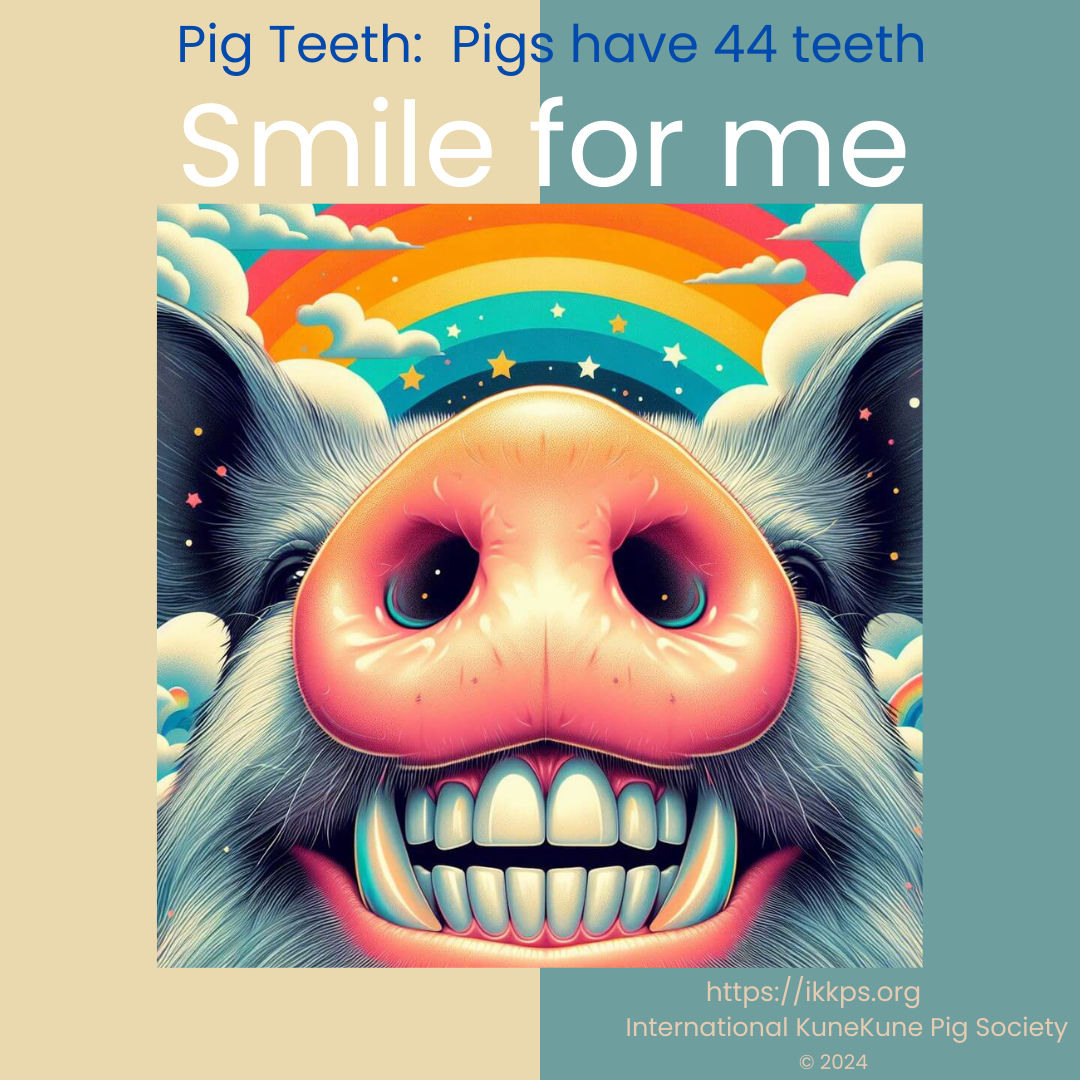
Premolars:
These are located between the canines and molars and are used for tearing and grinding food. Pigs have 16 premolars altogether: eight on the top and eight on the bottom. Additionally, there are eight premolars on each side of their mouth. Notably, there is a large gap called diastema between the upper canine and the first premolar. Diastema means a space separating teeth of distinct functions, especially that between the biting teeth (incisors and canines). In the lower jaw, the first premolar is very small and is located right behind the canine12. These premolars play a crucial role in grinding and processing the variety of foods that pigs consume.
Molars:
Located at the back of the mouth, these are used for grinding food thoroughly. Pigs have 12 molars altogether; six on top, six on the bottom, and six to a side1. These molars are the biggest chewing teeth in a pig’s mouth. Both the premolars and molars are known as brachydont teeth, which means they have low crowns (ridges). These teeth play a crucial role in grinding up the variety of foods in a pig’s diet
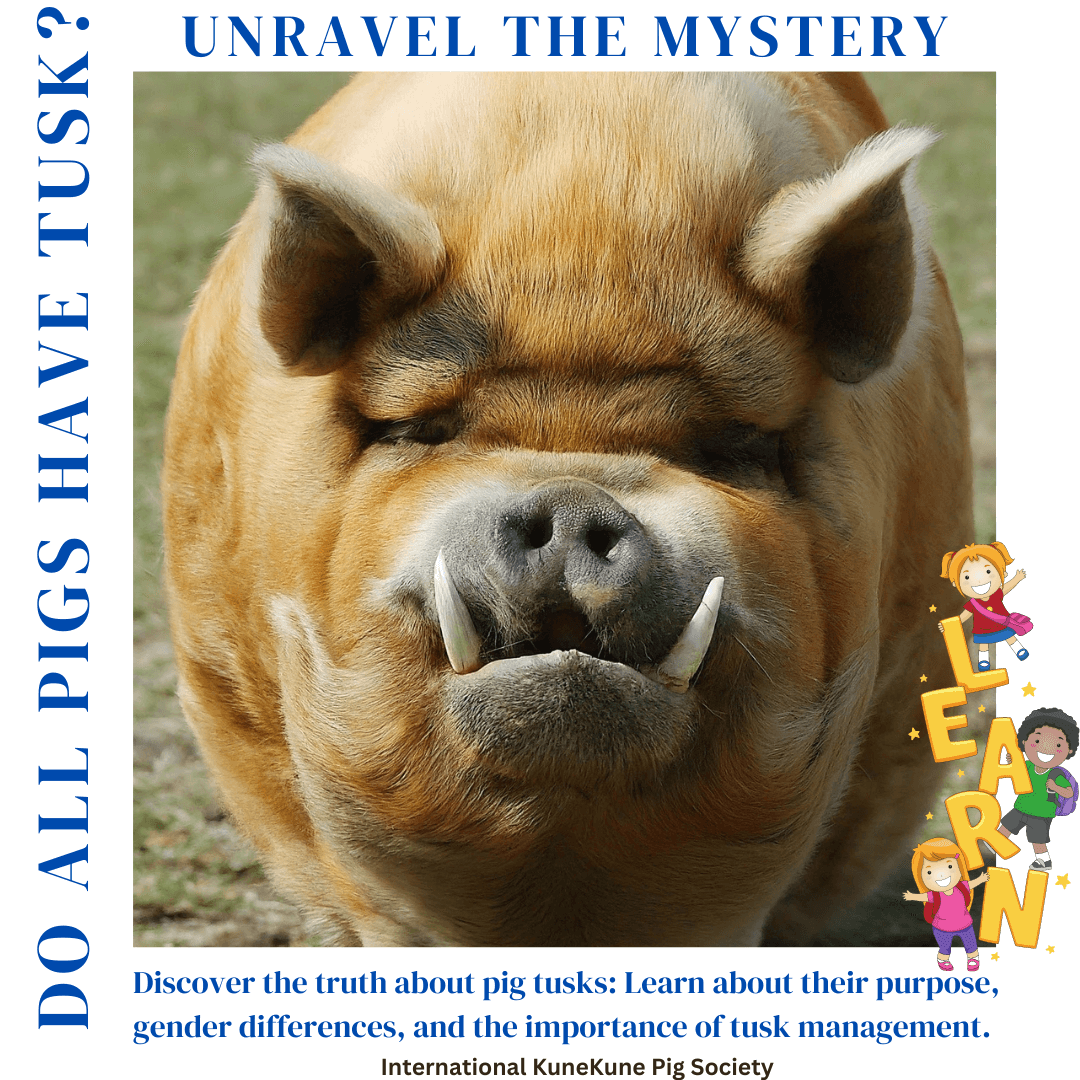
Does Gender Matter?
Male pigs typically grow larger tusks. These tusks start developing as permanent teeth around 18 months old and continue to grow throughout their lives. These elongated teeth serve multiple purposes which we will discuss further down in this article.
Female pigs, on the other hand, have shorter or smaller tusks that usually do not protrude significantly from their mouths. They may be barely noticeable. However, they still play a crucial role in a female pig’s life.
Neutered Pigs: Neutering a male pig (castration) can slow down or even completely halt tusk development. This is because neutering can affect their growth.
Why Do Pigs Develop Tusks?
Pigs use their tusks for various purposes including establishing dominance within their social groups, defending themselves against predators, and foraging. However, domestic pigs tend to not use their tusks for these reasons and owners may remove or trim them for safety concerns.
The primary use of tusks in male pigs, especially wild boars, is for fighting and defense. When confronted by strangers or intruders, male pigs can go on the offensive using their tusks as weapons. In the wild, male pigs also use their tusks to protect themselves from smaller predators. The primary function of tusks for pigs is for self-defense.
Tusk in Wild Pigs
Even among wild pig species, there are variations in tusk development. While wild boars are well-known for their impressive tusks, other wild pig species like warthogs and babirusa have unique tusk arrangements. Warthogs have prominent upper tusks that curve upwards, while babirusa have upper canines that grow through the top of their snout.
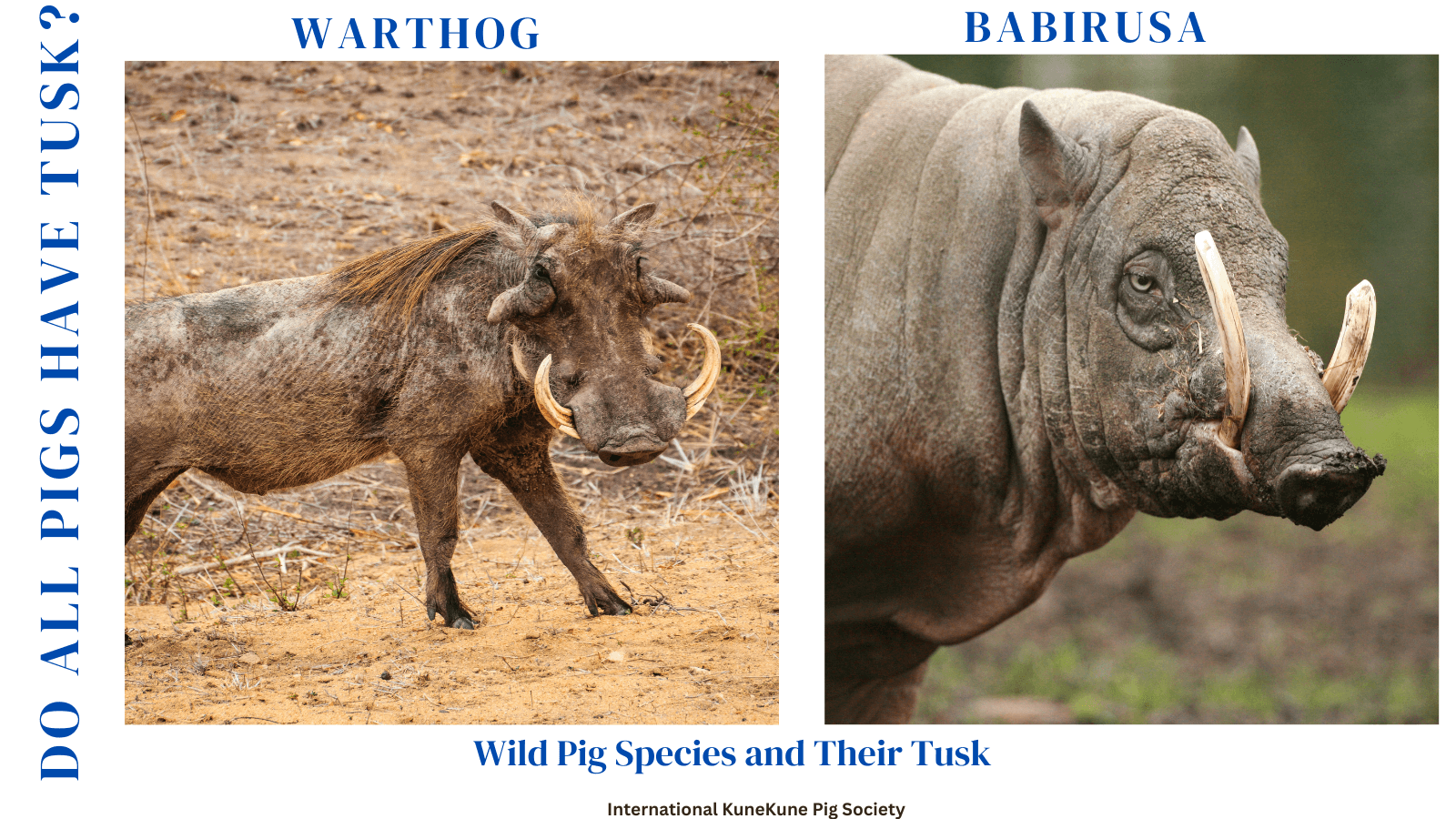
Domesticated Pigs and Tusk
Domesticated pigs, whether raised for meat or kept as pets, often have their tusks trimmed or removed. This is because, in captivity, pigs do not need to defend themselves or attack others for food. Their handlers or owners provide them with sustenance and protection. However, there are some important considerations for pig farmers, especially those with children who will be interacting with the animals. Safety and personality are important factors to take into account when making a decision.
KuneKune Pigs and Tusk
Certainly, I would like to take a moment to discuss the KuneKune Pig breed. Known for their friendly and docile nature, these pigs are easy to handle. However, it's important to be cautious of a boar's tusks, especially around children. While our boars are not mean or ill-tempered, they can accidentally gouge you with their tusks.
To prevent this from happening, I trained all of my boars at an early age. I would call them "head on" and reward them with treats such as apple slices or grapes, along with pets, scratches, and belly rubs. As a result, when they would approach from the side, near my legs, I would step away from them, and they would not receive any reward like petting or treats. I began this training from piglets up to adults. They learned the difference quickly and became gentle and loving individuals. I could enter their area, move them to another area, and not worry about my safety or that of my granddaughters.
Should I Remove the Tusks?
There are considerations when deciding if you want to trim or remove the tusks.
- Natural Aspect: Some owners consider tusks a natural part of the pig’s body and prefer not to remove them completely.
- Ethical Concerns: Owners avoid tusk removal to prevent causing harm or discomfort to their beloved pigs.
- Exotic Appeal: Some intentionally select pigs with fully grown tusks to add an exotic touch.
- Safety Concerns: Some will remove or keep their pig's tusk trimmed especially with children that interact with their pigs.
- Fencing Concerns: Another consideration is fencing. Occasionally the best-behaved boar will get tusks caught on a fence.
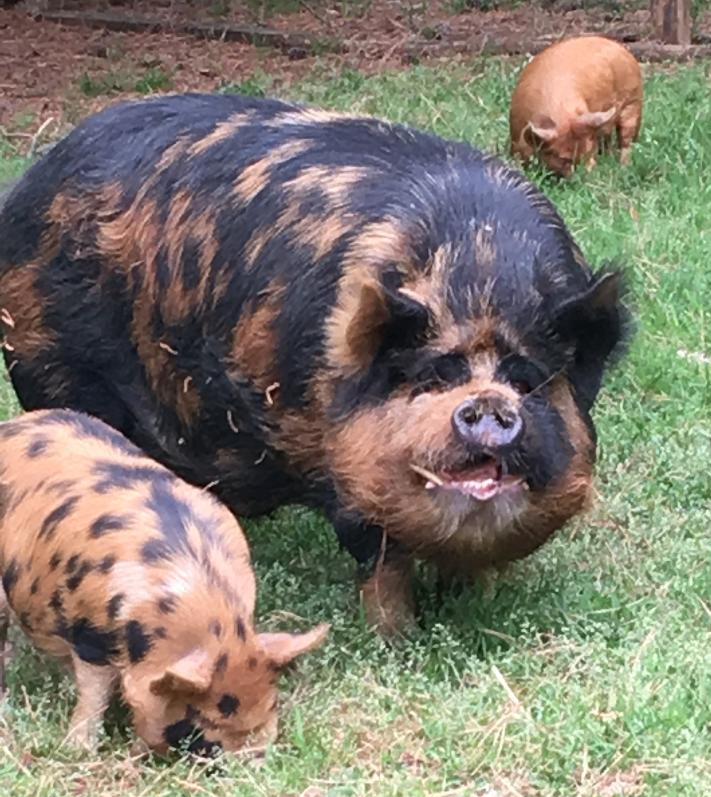
Young boar who broke off one side of his tusk. This does happen!
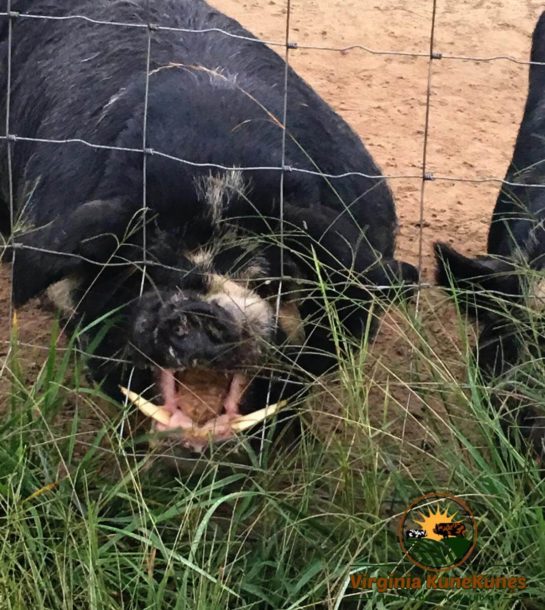
Older boar with full tusk! See how they could get caught in field fencing?
This is a decision that each domesticated pig breed should choose for themselves. I think that the breed of pig and the individual personalities of your pigs can be a huge factor in making this decision for your pigs. KuneKune pig breeders can certainly do as I did and train your boars well and always know where your boar is when you are in their area. Be overly cautious when there is a female in heat in the area of your boar as well.
I have had pigs get caught in fences. In my 10 years of breeding, this happened to me twice. It is scary however, having bolt cutters or wire cutters handy will help you get them free quickly.
Cutting and Trimming Tusks
Here are some things to know about Cutting and trimming tusks.
- Permanent Removal: Completely removing tusks is a one-time process. Once gone, they will not grow back. This is not the usual method preferred by most.
- Trimming: Trimming tusks is an ongoing effort. If done by a veterinarian, it incurs constant costs. You can easily learn to do this yourself. Please see the video at the end of this article to see how it is done.
- Sedation: During tusk removal or trimming, sedation may be necessary to minimize stress and ensure the pig’s safety. Some owners will give their pigs melatonin to calm them when they have trimmings done or even give them a “cold one” – a beer or two to relax them. They relax us! It has the same effect on a pig. Now don't go telling everyone that IKKPS said to get your pig drunk!
Video by Hog Heaven which is a rescue pig farm.
Conclusion
So, the next time you encounter a pig, take a moment to appreciate those fascinating tusks—they are not just ivory ornaments but essential tools for survival in the wild. Whether wild boars or domesticated Kunekune pigs, tusks remain a captivating aspect of pig biology. Remember, tusks tell a story—a tale of resilience, defense,
and the wild spirit that resides within every pig.
Registry Office
17500 Hamilton Arms Court Dewitt, VA 23840